When should I water my succulents? That question raced through my mind as I stared at my once-thriving Echeveria, its leaves dull and shriveled like forgotten parchment.
I had followed every care guide and tip, yet here it was—a victim of my overzealous watering schedule.
Sound familiar? You are not alone.
Succulents are deceptively simple, their plump, vibrant leaves hinting at resilience.
But behind that hardy exterior lies a delicate balance.
Too much water, and they drown in their roots.
Too little, and they wither into brittle shadows of their former selves.
The frustration is real, but the solution is surprisingly simple: timing.
Imagine this: your succulents flourishing, their leaves plump with hydration, and their colors vivid as a desert sunrise.
All it takes is understanding their rhythm, learning their silent cues, and embracing the joy of their resilience.
In this guide, I will show you the art of when you should water your succulents so you can stop second-guessing and start growing a collection that thrives year-round.
Let’s dig in.
Also Read: Sun Stress Succulent Sunburn Care Watering

Why Watering Succulents Is Tricky
Caring for succulents often feels like walking a tightrope.
Unlike most plants, succulents thrive in dry, arid conditions, making their watering needs unique and, at times, confusing.
What works for your leafy pothos or thirsty monstera can quickly spell disaster for a succulent.
One extra watering session could send their roots into a soggy spiral of decay.
On the flip side, their drought-resistant nature might lull you into neglect.
Days turn into weeks, and suddenly, your jade plant’s leaves are shriveling into crispy reminders of forgotten care.
It’s not about how much water they get; it’s about when they get it.
That’s the delicate dance of succulent care—balancing their thirst for life with their disdain for too much moisture.
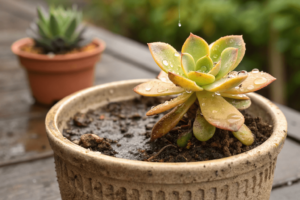
The Secret to Thriving Succulents: Perfect Timing
Succulents operate on nature’s clock, not ours.
In their natural habitats—rocky deserts or sandy coastlines—they endure long periods of drought followed by brief, intense rains.
This rhythm is key to understanding when to water them.
The perfect timing mirrors this cycle, giving your plants enough moisture to drink profoundly and store it for dry spells.
Mastering this timing doesn’t require a green thumb, just a little observation and a lot of patience.
Once you crack the code, your succulents will transform from struggling survivors to radiant showpieces of health and vitality.
Understanding Your Succulents’ Watering Needs
No two succulents are the same, and their watering needs can vary based on species, environment, and even the time of year.
Some varieties, like Aloe Vera, have thicker leaves that store more water, allowing them to go longer without a drink.
Others, like lithops, require an incredibly light touch, as their compact form can be easily overwhelmed by overwatering.
Your succulent’s environment also plays a role.
Indoor plants in low-light conditions will need less frequent watering than their sun-soaked outdoor counterparts.
Temperature, humidity, and even the type of soil can influence how thirsty your succulents are.
How Succulents Store Water
Succulents are nature’s water tanks, storing moisture in their fleshy leaves, stems, and roots.
This unique adaptation allows them to survive in some of the harshest environments on Earth.
When water is available, they absorb as much as possible, storing it for the inevitable dry spell.
But here’s the catch: their storage capacity has limits.
Overfill the tank (aka overwater), and their cells can burst, leading to mushy leaves and root rot.
Understanding how they store water helps you appreciate why they need such careful attention.
Why Overwatering Is the #1 Killer
Overwatering is the kryptonite of succulents.
While most plants thrive on regular hydration, succulents are easily overwhelmed.
Excess water causes their roots to sit in soggy soil, suffocating them and inviting fungal diseases.
The first signs of overwatering are subtle—soft, translucent leaves or yellowing at the base.
Left unchecked, this quickly escalates to a rotten mess.
The golden rule? When in doubt, let it dry out.
It’s always easier to revive a thirsty succulent than to rescue one drowning in water.

Signs Your Succulents Need Water
Succulents are experts at signaling hydration needs, but you must know how to read their subtle language.
Observing their leaves, stems, and even the soil is the key.
If you pay close attention, your plants will tell you exactly when they’re thirsty.
Droopy Leaves: A Cry for Help
Droopy or sagging leaves are the first signs that your succulent is thirsty.
Unlike overwatered plants, which have mushy leaves, underwatered succulents will look soft and slightly limp.
It’s as if they’re saying, “Hey, I need a drink!” This is your cue to check the soil and see if it’s time for some hydration.
Wrinkled Leaves vs. Firm Leaves
Wrinkled leaves are another telltale sign that your succulent is thirsty.
When their internal water reserves deplete, the fleshy leaves, like human skin, shrivel during dehydration.
Healthy, well-watered succulents will have firm, plump leaves. If you notice wrinkling, it’s time to check your watering schedule.
However, be cautious. Overwatering can cause similar issues, such as softened leaves.
This is why looking at other indicators, like soil dryness, is essential to confirm the problem.
Soil Dryness Test: The Ultimate Indicator
Testing the soil is the fastest and most reliable way to determine if your succulent needs water.
Use your finger to poke about an inch deep into the soil. If it feels scorched, your plant is likely ready for watering.
Alternatively, a moisture meter can provide more precision.
Ensure the reading falls on the drier side before you grab your watering can.
Wet soil? Hold off and check again in a day or two.
When Should You Water Your Succulents?
Timing your watering schedule is crucial for happy, thriving succulents.
A general rule of thumb is to water only when the soil is arid.
For most succulents, this could mean watering every 7–14 days, but the exact frequency depends on factors like temperature, humidity, and the pot size.
For potted indoor succulents, it’s wise to err on caution.
Overwatering indoors is much easier because evaporation happens slower compared to outdoor plants.
Stick to the dry-soil rule, and you will rarely go wrong.
Seasonal Changes: Summer vs. Winter Watering
Your succulents’ water needs change with the seasons.
During summer, when they’re actively growing, they may require more frequent watering.
But most succulents enter a dormancy phase in winter and need significantly less water.
Think of winter watering as maintenance mode—just enough to keep them alive without encouraging active growth.
Once temperatures rise and sunlight increases, you can resume a more regular schedule.
Timing Matters: Morning or Evening?
When watering succulents, timing isn’t just a minor detail—it’s a game-changer.
Watering in the early morning is ideal because it gives the soil time to absorb moisture before the day’s heat causes evaporation.
This ensures your plants have plenty of hydration to start their day.
Avoid watering in the evening, as sitting moisture can lead to fungal growth and root rot.
A quick morning splash? Perfect. A late-night soak? Risky business.

How to Water Succulents the Right Way
Watering succulents might seem straightforward, but there’s a bit of art and science to doing it right.
These resilient plants have unique needs, and understanding how to meet them will make the difference between a thriving succulent and one that struggles.
The Soak and Dry Method Explained
The “soak and dry” method is the gold standard for watering succulents.
Here’s how it works: water your plant deeply until water runs out of the drainage holes, then allow the soil to dry out completely before watering again.
This technique mimics their natural desert environment, where they receive occasional heavy rainfall followed by long, dry spells.
Remember, consistency is key.
Avoid the temptation to “top off” with small amounts of water, which can confuse the plant and lead to shallow root growth.
Avoiding Common Watering Mistakes
Overwatering is the number one cause of succulent death. Signs of overwatering include mushy leaves, discoloration, and even rotting stems.
On the flip side, underwatering can lead to shriveled leaves and stunted growth.
To avoid these pitfalls, always check the soil before watering.
And if you’re in doubt, it’s better to wait an extra day than to water prematurely.
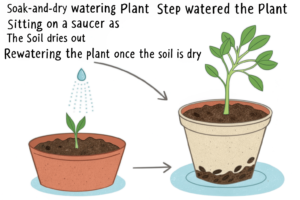
Factors That Affect Watering Frequency
No two succulents are alike when it comes to watering needs. Several factors influence how often you should water, including climate, temperature, and even the pot you use.
Climate and Temperature: Hot vs. Humid
In hot, arid climates, succulents may need water more frequently as the soil dries out faster.
In contrast, humid environments slow evaporation, requiring less frequent watering.
Keep an eye on your plant’s condition and adjust accordingly.
Indoor vs. Outdoor Succulents
Due to controlled temperatures and reduced exposure to sunlight and wind, indoor succulents typically need less water than their outdoor counterparts.
Outdoor succulents, especially those in direct sun, may require more frequent hydration to counteract faster soil drying.
The Role of Pot Size and Drainage
The size and type of pot can dramatically affect watering.
Smaller pots dry out more quickly than larger ones, so plants in tiny containers may need water more often.
Drainage is non-negotiable.
Pots without drainage holes are a recipe for disaster, as excess water gets trapped, leading to root rot.
Always opt for pots with good drainage, and if you fall in love with a decorative pot without holes, use it as a cover pot instead.
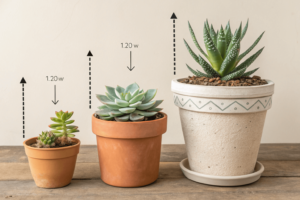
Succulent Soil Matters: The Foundation of Proper Watering
Your soil type is pivotal in how well your succulents handle watering.
Standard potting soil is too dense and retains too much moisture for these desert plants.
Best Soil for Succulents: What to Look For
The ideal soil for succulents is light, airy, and drains quickly.
Look for mixes labelled explicitly as “succulent” or “cactus” soil.
These are typically formulated with sand, perlite, or pumice to ensure excess water doesn’t linger.
Why Fast-Draining Soil Is Essential
Fast-draining soil prevents water from pooling around the roots, which is the quickest way to rot your plant.
It also allows for proper airflow, keeping the roots healthy and happy.
If you can’t find premade succulent soil, you can make your own by mixing standard potting soil with equal sand and perlite.
Watering Tips for Different Types of Succulents
Each succulent has its quirks when it comes to hydration.
By understanding their unique needs, you can avoid over- or underwatering and help your plants thrive.
Echeveria: Less is More
Echeverias are one of the most popular succulents and are prone to overwatering.
Water sparingly, ensuring the soil dries out entirely between sessions.
During the dormant winter months, watering is reduced even further.
Aloe Vera: A Thirstier Succulent
Unlike other succulents, Aloe Vera appreciates slightly more water due to its thicker leaves that store moisture.
Be cautious—water deeply, but allow the top 2-3 inches of soil to dry out before watering again.
Haworthia: A Shade-Loving Hydration Schedule
Haworthias thrive in low-light environments and don’t require as much water.
Water only when the soil is dry to the touch, and be especially cautious during the cooler months when they need even less hydration.
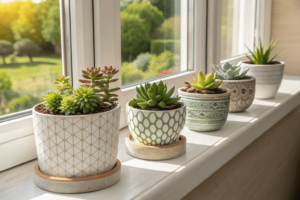
Water Quality and Its Impact
What you water your succulents with is as important as how often you do it.
While they’re resilient plants, water quality can affect their long-term health.
Is Tap Water Safe for Succulents?
Tap water is generally fine for most succulents, but if your local supply is high in chlorine or minerals, it might cause leaf spots or salt buildup in the soil.
If you notice white crusts on the soil or leaf discoloration, your water quality could be the culprit.
The Benefits of Using Distilled or Rainwater
For optimal care, consider using distilled water or harvesting rainwater.
These options are free from chemicals and heavy minerals, creating a purer environment for succulents.
They are especially beneficial for finicky varieties like Lithops or rare species.
What Happens if You Overwater
Overwatering is the leading cause of succulent troubles.
Understanding the warning signs and taking quick action can save your plant from a grim fate.
Warning Signs of Overwatered Succulents
If your succulent’s leaves are mushy, translucent, or falling off with a gentle touch, it’s likely drowning.
Yellowing or blackened stems and roots are additional signs of overwatering.
How to Save an Overwatered Succulent
First, stop watering immediately.
Remove the plant from its pot and inspect the roots.
Trim away any black, mushy, or rotting roots with sterile scissors.
Let the plant dry for a day before repotting it in fresh, dry, fast-draining soil.
Once repotted, resume watering cautiously only when the soil is bone dry.
Following these tips will ensure that your succulents stay vibrant and healthy and are ready to brighten up your space for years to come!
Common Watering Mistakes (And How to Fix Them)
Even with the best intentions, watering mistakes can happen.
Understanding and correcting these common missteps can save succulents from stress or irreversible damage.
The Misting Myth
One of the most persistent misconceptions about succulents is that misting is sufficient for hydration.
While a light mist might seem like a gentle way to water, it only adds surface moisture to the leaves without nourishing the roots.
Instead, focus on deep watering that saturates the soil.
Allow the water to drain completely, ensuring the roots receive the hydration they need while avoiding stagnant water.
Misting is best reserved for propagation or specific species that thrive in higher humidity, like air plants.
Why Schedules Sometimes Fail
A rigid watering schedule might seem foolproof, but succulents don’t thrive on a one-size-fits-all approach.
Factors like seasonal changes, humidity, and soil type can all impact their water needs.
Sticking to a schedule without considering these variables can lead to over- or underwatering.
The solution? Let your plant guide you.
Check the soil’s moisture level regularly, and water only when completely dry.
Adjust your routine based on environmental conditions, such as increased watering during hot summers or less during winter dormancy.
Recovering from Overwatering
Overwatering is succulent owners’ most common mistake, often leading to root rot.
But don’t panic—many plants can be saved with prompt action.
Start by removing the succulent from its pot and inspecting the roots.
Trim away any mushy, blackened sections using sterilized scissors.
Let the plant air-dry for a day or two to allow the remaining healthy roots to recover.
Next, report your succulent in fresh, fast-draining soil and a pot with drainage holes.
Water sparingly for the first few weeks, giving the roots time to reestablish themselves.
With careful monitoring, your plant can recover from overwatering and thrive again.
Avoiding these mistakes and following these corrective steps will set you on the path to becoming a confident succulent caretaker, ensuring your plants flourish for years to come!
Underwatering: Can It Be Just as Harmful?
While overwatering tends to dominate succulent care conversations, underwatering can be equally harmful.
Succulents are drought-tolerant but not invincible.
Understanding the signs of underwatering and how to revive thirsty plants can prevent permanent damage.
Signs of Thirsty Succulents
A dehydrated succulent often has shriveled, wrinkled leaves that feel limp rather than firm.
The vibrant colors may fade, and growth can become stunted.
The entire plant may begin to droop in severe cases, signaling it’s time to step in.
Reviving Dried-Out Plants
Start with a deep, thorough watering to nurse a parched succulent back to health.
Submerge the pot in a water bowl for 10-15 minutes, allowing the roots to absorb moisture.
Avoid overcompensating with frequent watering—resume a balanced schedule once the plant shows signs of recovery, such as firmer leaves and improved coloration.
Succulent Care During Dormancy
Succulents have dormant seasons when their water needs drastically change.
Adjusting your routine during this period is key to your survival.
Understanding Dormant Seasons
Most succulents enter dormancy during winter, but some, like certain cacti, rest during summer.
Growth slows or halts during this time, and water requirements decrease significantly.
Research your succulent’s dormancy period to avoid overwatering when resting.
Adjusting Your Watering Routine for Dormancy
Cut back on watering during dormancy, allowing the soil to remain dry longer between sessions.
Water sparingly, just enough to keep the roots from drying out completely.
This seasonal adjustment mimics their natural habitat and helps them thrive year-round.
Tools to Make Watering Easier
The right tools can simplify succulent care and take the guesswork out of watering.
Best Watering Cans for Succulents
Choose a watering can with a long, narrow spout for precise application. This prevents water from splashing onto the leaves, reducing the risk of rot.
Using Moisture Meters: Are They Worth It?
Moisture meters are game-changers for succulent enthusiasts.
These handy gadgets measure the soil’s moisture level, ensuring you water only when necessary.
While not essential, they’re an excellent investment for anyone struggling with over- or underwatering.
Myths About Watering Succulents
Misinformation about succulents abounds. Let’s debunk some common myths to help you care for your plants better.
Myth: Succulents Don’t Need Water
Even though succulents store water, they still need regular hydration. Ignoring their watering needs can lead to dried-out leaves and a stressed plant.
Myth: Spraying Leaves is Enough
Misting succulents may help with humidity, but it doesn’t provide the deep hydration their roots need. For healthier plants, focus on watering the soil directly.
Advanced Tips for Succulent Enthusiasts
These advanced tips can make a big difference for seasoned, succulent lovers looking to perfect their care routine.
Creating a Watering Schedule
Keep a watering journal or set reminders to establish a consistent routine tailored to your plant’s needs.
Record factors like frequency, season, and plant type for a personalized approach.
Monitoring Environmental Changes
Be mindful of temperature, light, and humidity changes, as these can impact your succulent’s watering needs.
For example, succulents in dry, sunny spots may require more frequent watering than those in cooler, shaded areas.
By mastering these techniques, you will keep your succulents alive and help them thrive, becoming the envy of every plant enthusiast!
Conclusion
Mastering the art of watering succulents may take patience, but once you understand their unique needs, you will see them thrive.
From knowing when and how to water to using the right soil and tools, these small plants can be incredibly resilient and rewarding to care for.
Thriving succulents start with proper care, which means paying attention to their needs.
Whether you’re a succulent novice or a seasoned plant parent, learning the nuances of watering will help you cultivate a collection of healthy, vibrant plants.
Your succulents are more than just beautiful additions to your home; they are little survivors capable of bouncing back with attention.
By understanding their water requirements and avoiding common mistakes, you can enjoy lush, happy succulents that continue to thrive year-round.
FAQs
Q: How Often Should I Water My Succulents?
Succulents prefer to dry out completely between waterings. Depending on the environment, this typically means watering every 1-2 weeks. However, always check the soil before watering to ensure it’s dry. Adjust your watering schedule for seasonal changes, with less frequent watering during winter.
Q: Can I Water Succulents with Ice Cubes?
While using ice cubes may seem simple, it’s not ideal. Ice cubes melt too slowly and can cause uneven watering. It’s best to water your succulents using room-temperature water, pouring it directly into the soil until it drains out the bottom. This method ensures the water reaches the roots evenly and prevents shock from sudden cold temperatures.
Q: What Happens if I Skip Watering for Too Long?
If you skip watering for too long, succulents can survive for a while, thanks to their water-storing ability. However, prolonged drought can lead to dehydration, causing the leaves to shrivel or drop off. If you notice signs of dehydration, give your plant a deep watering, but make sure the soil is well-draining to avoid root rot. It’s better to under-water than over-water, so err on caution and check the soil frequently.
With these tips, you’re on your way to becoming a succulent expert! Your plants will thank you for the extra care, and soon, you’ll have a collection of thriving, beautiful succulents to show off!
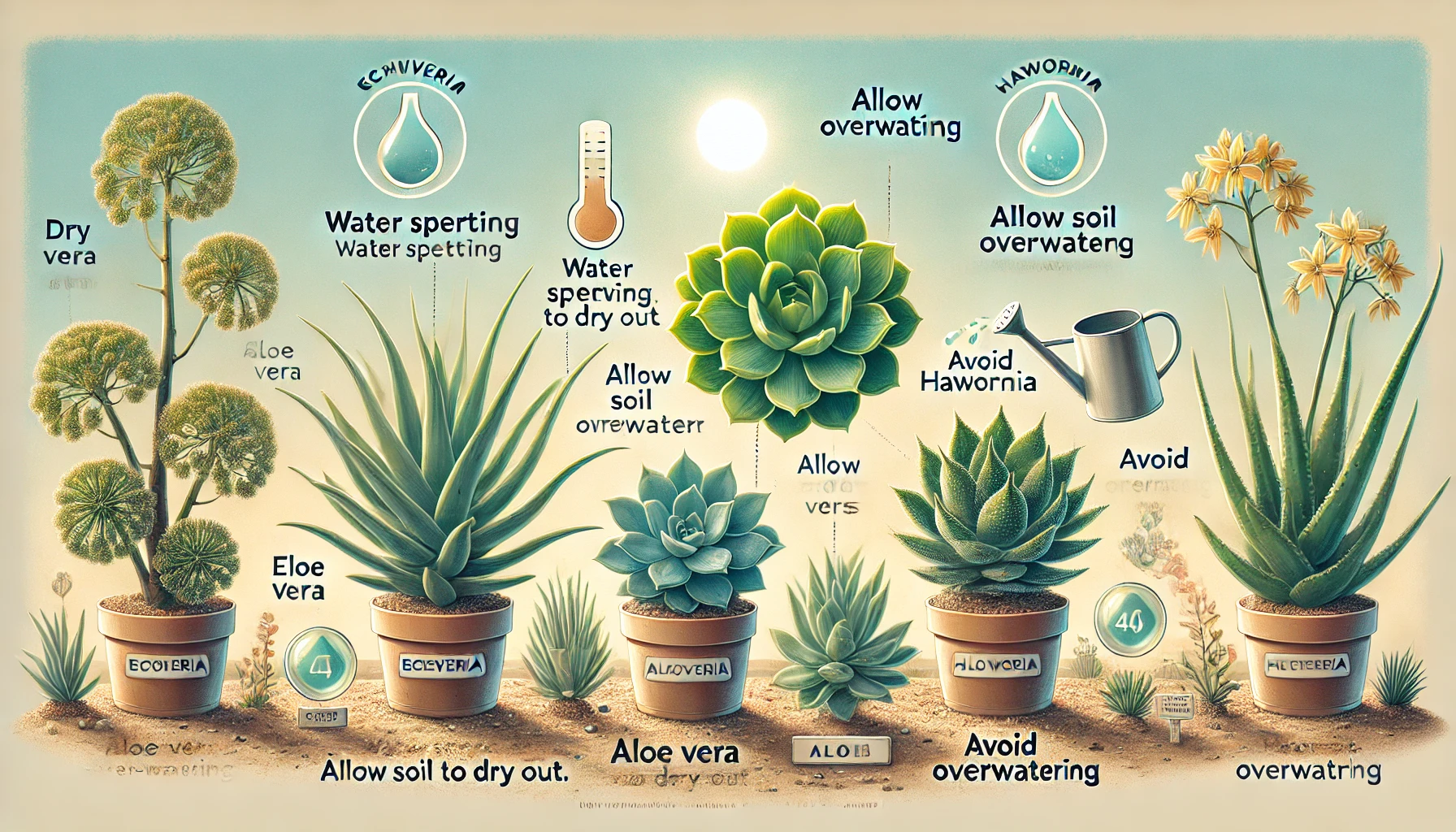








4 Responses